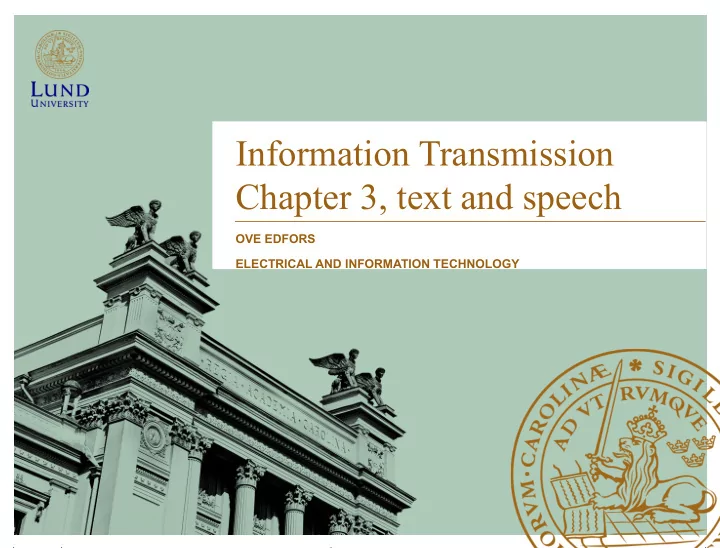

Information Transmission Chapter 3, text and speech OVE EDFORS ELECTRICAL AND INFORMATION TECHNOLOGY
Learning outcomes Understand some of the most important concepts regarding ● information and its representation (bits, bandwidth, SNR), how to perform decibel calculations, ● what text is and how it can be coded, ● signal frequency content/components and spectrum, ● voice generation and properties, ● audio quality measures, and ● basics of (digital) audio/music recording. ● 2
Some concepts • Bits – Small pieces of information – The information in a 2-valued variable • Bandwidth – Fourier transform of a signal – (The number of bits/s from a source) • Signal to noise ratio – SNR – Average signal power / average noise power 3
Decibel - dB • Convenient when comparing values with a really small difference or a really large one • If A and B are power values • Or if A and B are amplitude values 4
What is text? Def: A collection of letters (numbers, symbols, …) to form words (math figures, software, crypto-text, …) Symbols come from a set called the alphabet Do we have any standard alphabets? 5
ASCII american standard for information interchange 6
Frequency and bandwidth 7 7
Frequency Sinusoidal signals: One cycle or period Time Frequency = Number of cycles per second [Herz] Example :The AC power in your home has a frequency of 50 Hertz. This also means that the cycle time is 20 ms. 8 8
Adding sinusoids [1] 25 Hz What frequency? 50 Hz Is no longer a pure sinusoid. Contains TWO frequencies. 9 9
Adding sinusoids [2] Can we build ”any” signal by adding sinusoids? Yes! 50 Hz 100 Hz 150 Hz 200 Hz 250 Hz After an infinite number of sinusoids we get a sawtooth signal! 10 10
Spectrum 11 11
Spectrum [1] If we can build any signal by adding sinusoids ... can we view the frequency content of a signal in some way? Amplitude This is the amplitude spectrum of the ”sawtooth signal”. 0 50 100 150 200 250 Frequency [Hz] 12 12
The vocal tract • Vocal cord produces the tone, the rest is forming the sound • Voiced sounds/unvoiced gomsegel sounds • 5-10 sounds/s in speech struplock matstrupe stämband luftstrupe 13
Voiced/unvoiced sounds 14
Main energy in 100-800 Hz (speaker recognition) 800 Hz-4 kHz (intelligibility range) Less than 1% above 4 kHz harmonics fundamental
Demo: Audio analyzer
Standard phone line • 40 dB signal to noise ratio (SNR) desired • 4 kHz bandwidth • Uses uncompressed PCM, as opposed to cell phones where there is speech coding 17
3 bit PCM • 2 3 regions (bins) • A deviation means an error – noise • SNR= 6 b -C 0 dB • If C 0 =7.3,,,,, how many bits do you need? 18
Reconstruction error 19
Music • Highly dynamic 30-50 dB power variations • Funtamental tone+overtones, 20-20 000 Hz – Sensitive in the range 100-4000 Hz – No direction below 100 Hz 20
Music recording on a CD 2 channels*44.1 k samples/s*16 bits/sample result in a bit stream of 1.4 Mbit/s 21
How many bits are there? 22
SUMMARY Signal quality – dB measure ● Power ratio in dB: – Amplitude ratio in dB: – Text: ● Sequence letters (symbols from an alphabet) forming words – Several coding standards, e.g. ASCII – Sinusoidal signals ● Have frequency (period time) and amplitude – Can be added to form signals of other shapes – Amount of each sinusoidal used (amplitude) called the spektrum – Voice ● Voice signals/speech created by vocal cords producing the tone – … and rest of the voice aparatus forming the spectrum Voiced and univoiced sounds – Most information contained below 4 kHz – 40 dB SNR PCM coding: 8 kHz sampling x 8 bit/sample = 64 kbit/sek – Music ● Different instruments playing the same tone differ in their over-tones – Frequency span: from 20 Hz to 20 kHz – CD quality PCM (stereo): 44.1 kHz sampling x 2 channels x 16 bit/sample = 1.4 Mbit/sek – Error correcting codes used to protect against errors when reading from CD – 23
24
Recommend
More recommend